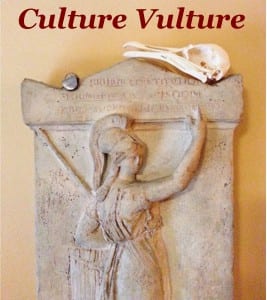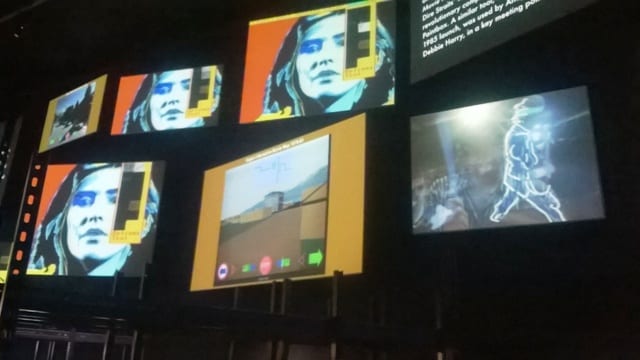Culture Vulture: Digital Revolution at the Barbican
By Mark Carnall, on 28 August 2014
It’s been a while since we had a culture vulture review on the blog. For the uninitiated we share our thoughts on recent museum exhibitions and displays to demonstrate that we don’t all get put into a cupboard at the end of the day. Last weekend I made my way down to the Barbican Centre to see the tantalisingly titled Digital Revolution: An immersive exhibition of art, design, film, music and videogames. As you may have gathered, I’m a bit of a geek (is there even a need to use the label anymore? We’re all geeks now) and I’m always interested to see how ‘digital’ translates into museum exhibitions. A number of exhibitions I’ve been to in the past about digital art, design and video games always manage to make what should be exciting, schizophrenic and contemporary seem sterile and uninspiring through the lense of a museum display. How did Digital Revolution fare in my eyes?
The exhibition bills itself as an immersive exhibition of art, design, film, music and videogames and the exhibition is roughly divided into sections dealing with each. The first section is dedicated to video games with a carefully selected collection of playable games including Pong, Tetris, Super Mario Bros. and the original Tomb Raider. In this section there’s a huge array of screens which play excellently chosen clips and sounds from games, film and music (including, amongst others, the video for Dire Straits Money For Nothing and the end scene from Jurassic Park with that roar). There are also a number of well chosen early web interactive games/artworks. I’d be really interested to see the visitor evaluation for this section of the exhibit, as the sights and sounds as well as authentic display monitors, original consoles and controllers and even the display furniture was so hugely nostalgic for me I was kind of blown away by it. It must seem oddly quaint and primitive for younger visitors and for older visitors I imagine it’s a noisy, neon, nerdy reminder of parts of the eighties and nineties they’d prefer was forgotten. I’m only minorly offended that my formative years can now be found in an exhibition classified as ‘Digital Archaeology’.
The next section is a focus on digital techniques used in film making and music, with interviews and interactives showing how films like Gravity and Inception were created as well as a selection of music videos created with or by digital techniques including Kilo by Light Light and an impressive music/illusion/video installation, Pyrimidi with the giant projected noggin of will.i.am. Further sections take you through some impressive interactive ‘art’ pieces, highlight some cool procedurally created digital art and there’s an area with an interactive 3D printer, the operation of which I couldn’t comprehend. The Barbican space is slightly problematic to negotiate but we managed to find the Indie games showcase and I was very happy to get some hands on time with darling indie games Bit.Trip, Super Hexagon Papers Please!, Proteus and others. As a seasoned gamer it wasn’t too problematic to pick up and play some of these, but whilst I was there, others seemed to find it hard to know how to begin even with instructions on the interpretation. This is one of the problems with playable games in museum exhibitions. Traditionally, many games are designed to be consumed in concentrated chunks normally in the privacy of your own home. Something is lost in playing a random chunk of a game in a gallery, video games lacking the universal accessibility of film and text.
The exhibition is rounded off with commissioned interactive pieces, the highlight of which was an interactive laser show (it’s the best way I can sum it up). When I was there there was something comedic in a collection of 30 year-olds dancing and playing with laser projections in silence in a smoky dance space.

Image of The Treachery of Sanctuary by Chris Milk at Digital Revolution at the Barbican Centre. Image by the author.
Overall, I enjoyed myself but as I mentioned earlier I’d be really interested to see what visitors who lived before, through or after the ‘digital revolution’ came away thinking. The exhibition is ambitious, tackling the challenge of bringing together all these strands of ‘digital’ under one umbrella. What unites or is important about the relationship between an interactive laser show and Wolfenstein? I can imagine the challenge in trying to create such an ambitious exhibition and I’m not sure that the sectioned narrative here holds together or even if there can be a ‘narrative’ when it comes to digital that could hold together.
Lastly, and this is an issue with all the exhibitions I’ve been to about ‘digital’, games, art and design produce ‘stuff’ but it’s the people and cultures that create them and interact with them that is more interesting and what should be part of the display. This could be said about all of history on display in museums, but seeing as much of the digital revolution is within living memory, some of the excitement, evolution and modern day developments can be sterilized when reduced to a series of token ‘objects’ taken out of time and place. As a museum curator I still subscribe to somewhat outdated notions that museums legitimise cultures and subcultures and Digital Revolution is another example of museums ‘getting there’ when it comes to displaying the digital.
Digital Revolution runs at the Barbican Centre until the 14th of September 2014. Entry is charged with a range of concessions.
Mark Carnall is the Curator of the Grant Museum of Zoology
2 Responses to “Culture Vulture: Digital Revolution at the Barbican”
- 1
 Close
Close




Interesting article Mark. I was born in the late (ish) sixties. Some of my younger sister’s contemporaries had BBC computers and I may have played packman, however this gaming thing did pass me by. Digital art is amazing though. The last show at the Barbican, a Jean Paul Gaultier retrospective used digital projection and was one of the best exhibitions I have ever been to, and that is saying something. I feel I should go and see this new exhibition, but I’m not yet sure why …